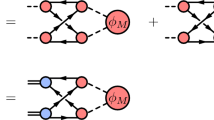Summary
In preceding papers electroweak gauge bosons, leptons and quarks have been assumed to arise from bound states of subfermions, where the subfermion dynamics is governed by a non-linear spinor field equation with appropriate regularization and globalSU(2)-U(1) invariance. The bound states were classified according to a shell model scheme and with respect to these shell model states the effective dynamics was investigated by means of weak mapping theorems formulated in functional space. In this paper an improved group-theoretical analysis of these shell model states as well as of the corresponding weak mapping is performed and the results are compared to the formulation of a phenomenological unbrokenSU(2)-U(1) gauge theory in functional space. For symmetric configurations of shell model states in isospin-superspin degrees of freedom one obtains twice as many states for leptons and quarks as in phenomenology, but apart from this difficulty, in the low-energy limit the effective dynamics of the shell model states coincides exactly with that of the phenomenologicalSU(2)-U(1) unbroken gauge theory. Furthermore, apart from symmetry breaking which is not discussed in this paper, the phenomenological quantum numbers of the first generation of leptons and quarks as well as of gauge bosons are correctly reproduced by the bound states of subfermions. A possible way is indicated to remove the superfluous shell model states from the theory.
Similar content being viewed by others
References
Buchmüller W.,Acta Phys. Austr. Suppl.,27 (1985) 517.
Mohapatra R. N.,Prog. Nucl. Part. Phys.,26 (1991) 3.
D’Souza I. A. andKalman C. S.,Preons, Models of Leptons, Quarks and Gauge Bosons as Composite Objects (World Scientific, Singapore) 1992.
Bellotti E.,Phys. World,7, No. 7 (1994) 37.
Lyons L.,Prog. Part. Nucl. Phys.,10 (1983) 227.
de Broglie L.,Théorie générale des particules à spin (2nd edition) (Gauthier-Villars, Paris) 1954.
Heisenberg W.,Introduction to the Unified Field Theory of Elementary Particles (Interscience Publ., London) 1966.
Gonzales-Mestres L.,Phys. Rev. D,23 (1981) 2055.
Harari H.,Phys. Lett. B,86 (1979) 83.
Shupe M. A.,Phys. Lett. B,86 (1979) 87.
Raitio R.,Phys. Scr.,22 (1980) 197.
Squires E.,Phys. Lett. B,94 (1980) 54;J. Phys. G,7 (1981) 247.
Wetterich C. H.,Are quarks and leptons composite states?, Freiburg preprint THEP 79/11 (1980).
Terazawa H., Chigashige Y., Akama K.,Phys. Rev. D,15 (1977) 480.
Nambu Y. andJona-Lasinio G.,Phys. Rev.,122 (1961) 345.
Stumpf H. andBorne Th.,Composite particle dynamics in quantum field theory (Vieweg Verlag, Wiesbaden/Braunschweig) 1994.
Stumpf H.,Z. Naturforsch. A,41 (1986) 683;41 (1986) 1399;42 (1987) 213.
Stumpf H. andPfister W.,Nuovo Cimento A,105 (1992) 677.
Pfister W.,Nuovo Cimento A,106 (1993) 363.
Grimm G.,Z. Naturforsch. A,49 (1994) 649.
Terazawa H.,Mexican School of Particles and Fields, Oaxtepec, Mexico 1984, AIP Conf. Proc. (USA),143 (1986) 122.
Pfister W., Rosa M. andStumpf H.,Nuovo Cimento A,102 (1989) 1449.
Pfister W.,Nuovo Cimento A,107 (1994) 1523.
Dürr H. P. andSaller H.,Nuovo Cimento A,53 (1979) 469;48 (1978) 505.
Saller H.,Nuovo Cimento A,64 (1981) 141;107 (1994) 1679.
Kramer P., John G. andSchenzle D.,Group Theory and the Interaction of Composite Nucleon Systems (Vieweg Verlag, Wiesbaden/Braunschweig) 1981.
Grimm G.,Elektroschwache Standardtheorie als effektive Dynamik von Bindungs-zuständen im Rahmen einer nichtlinearen Spinortheorie, Thesis, University of Tübingen, 1994.
Stumpf H., Fauser B. andPfister W.,Z. Naturforsch. A,48 (1993) 765.
Author information
Authors and Affiliations
Rights and permissions
About this article
Cite this article
Pfister, W., Stumpf, H. Effective dynamics in a subfermion shell model of leptons, quarks and electroweak gauge bosons. Nuov Cim A 108, 947–973 (1995). https://doi.org/10.1007/BF02730848
Received:
Accepted:
Published:
Issue Date:
DOI: https://doi.org/10.1007/BF02730848




